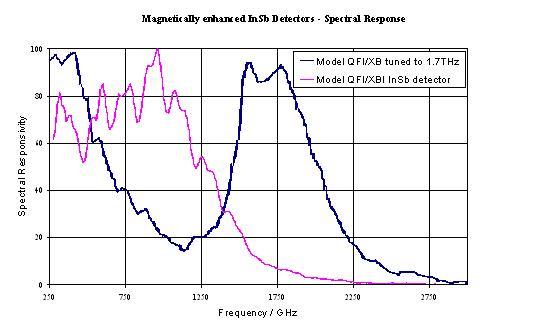Magnetically Enhanced Indium Antimonide (InSb) Hot-electron Bolometer
Models QFI/XBI and QFI/XB
| Detector electrical responsivity | >5 kV/W |
| Peak detector optical responsivity | > 3.5 kV/W |
| Detector electrical NEP | < 500 fW Hz-1/2 |
| Detector optical NEP | < 1.5 pW Hz-1/2 |
| Useful frequency range | 60 GHz to 1.5 THz (QFI/XBI), peak up to 2.5 THz (QFI/XB) |
| Frequency Response | ~500 kHz (-3 dB) |
| Operating resistance | 5 kOhm to 20 kOhm |
| Operating temperature | 4.2 K |
See below for notes relating to the above specification.
Our range of magnetically assisted detectors are intended for applications requiring high speed of response where sensitivity is crucial in the frequency range between 1 and 2.5 THz. The sensitivity of the InSb hot-electron bolometer (model QFI/X) can be enhanced between 500 GHz and 2.5 THz using magnetic resonance. For convenience we apply magnetic fields to detector elements using permanent magnets. The limitation of these detectors to a maximum frequency of 2.5 THz is determined by the maximum field strength that can be reasonably applied to a detector element by placing it between such permanent magnets. For high speed of response detection at still higher frequencies, photoconductors can be used.
Two distinct designs are offered:
- The inhomogeneously tuned detector – model QFI/XBI which uses a varying magnetic field strength across the detector. The resonance is therefore integrated over a wider frequency range up to a maximum of 1.5 THz
- The homogeneously tuned detector – model QFI/XB which uses a uniform magnetic field exposure, creating a single peaked response function. The peak frequency can be tuned between 1.5 and 2.5 THz and the typical peak width is 300 GHz at full-width-half-maximum
These detectors are available individually or as part of a complete detector system; further information on such systems is given here.
The figure below presents measurements of the spectral responsivity of two examples of these magnetically tuned detectors.

Notes on specification
- Detector optical responsivity is specified at 275 GHz
- Detector optical NEP is specified at 275 GHz (1 kHz modulation)
Example of System Optical Configuration
- Side looking direction of view, approximately 80mm above base
- f/2 quasi-parabolic Winston cone optic
- 25mm throughput (cone entrance aperture)
- HDPE window
- 3THz low pass multi-mesh filters at 77 K and 4.2 K
A 2 year guarantee is provided as standard on all QMC Instruments Ltd products.
Operating principles
Drude theory is used to explain the absorption of radiation by free electrons. In InSb at 4.2 K the electron-electron interaction time is 300 fs. This determines that absorption will be constant up to 500 GHz, beyond which it falls as the signal frequency to the power -1.8. Our measurements of spectral responsivity in these detectors broadly agree with this prediction. The result is that the unassisted detector (model QFI/X) loses a factor of almost 10 in sensitivity at 1.5 THz and more than a factor of 20 at 2.5 THz. The free-electron response at frequencies below 500 GHz is maintained for both models of magnetically enhanced detector.
Edited May11